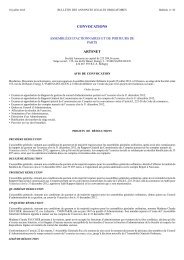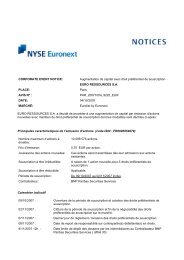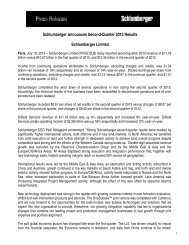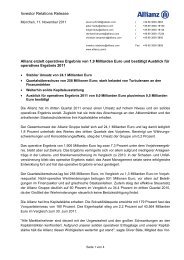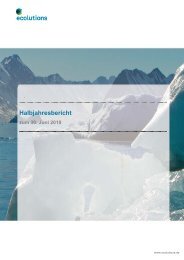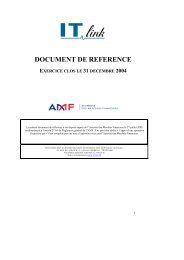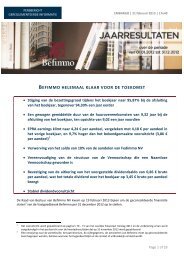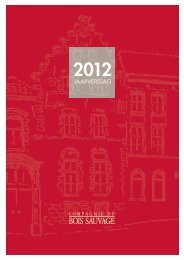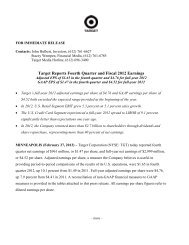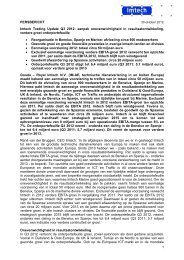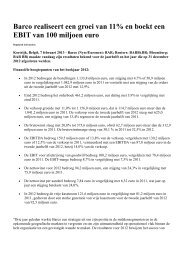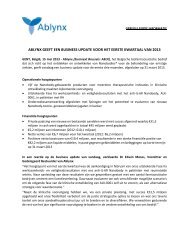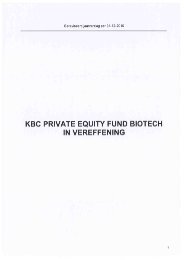2006 Annual Report
2006 Annual Report
2006 Annual Report
Create successful ePaper yourself
Turn your PDF publications into a flip-book with our unique Google optimized e-Paper software.
FIN 48, only tax positions that meet a “more likely than not”<br />
threshold at the effective date may be recognized or continue to<br />
be recognized. The cumulative effect of applying FIN 48, if any, is<br />
to be reported as an adjustment to the opening balance of<br />
retained earnings in the year of adoption. We are evaluating the<br />
impact that FIN 48 will have on our financial statements.<br />
In March <strong>2006</strong>, the FASB issued FAS No. 156,“Accounting for<br />
Servicing of Financial Assets” (“FAS No. 156”). FAS No. 156<br />
requires that all separately recognized servicing assets and liabilities<br />
are to be initially measured at fair value. It also allows entities<br />
to subsequently elect fair value measurement for its<br />
servicing assets and liabilities. This standard is effective for the<br />
first fiscal year beginning after September 15, <strong>2006</strong>, which is our<br />
2007 fiscal year. We have determined that FAS No. 156 will not<br />
have a material impact on our financial statements.<br />
In September <strong>2006</strong>, the FASB issued FAS No. 157,“Fair Value<br />
Measurements” (“FAS No. 157”). This standard defines fair value,<br />
establishes a methodology for measuring fair value and expands<br />
the required disclosure for fair value measurements. FAS No. 157<br />
is effective for fiscal years beginning after November 15, 2007,<br />
which is our 2008 fiscal year. Provisions of FAS No. 157 are<br />
required to be applied prospectively as of the beginning of the<br />
first fiscal year in which FAS No. 157 is applied. We are evaluating<br />
the impact that FAS No. 157 will have on our financial statements.<br />
In November <strong>2006</strong>, the Emerging Issues Task Force of FASB<br />
(“EITF”) reached a consensus on EITF Issue No. 06-8,“Applicability<br />
of the Assessment of a Buyer’s Continuing Investment under<br />
FASB Statement No. 66, Accounting for Sales of Real Estate, for<br />
Sales of Condominiums” (“EITF 06-8”). EITF 06-8 will require condominium<br />
sales to meet the continuing investment criterion in<br />
FAS No. 66 in order for profit to be recognized under the percentage<br />
of completion method. EITF 06-8 will be effective for annual<br />
reporting periods beginning after March 15, 2007, which is our<br />
2008 fiscal year. The cumulative effect of applying EITF 06-8, if<br />
any, is to be reported as an adjustment to the opening balance of<br />
retained earnings in the year of adoption. We are evaluating the<br />
impact that EITF 06-8 will have on our financial statements.<br />
2 | SYNTHETIC FUEL<br />
Operations<br />
Our synthetic fuel operation currently consists of four coalbased<br />
synthetic fuel production facilities (the “Facilities”), two of<br />
which are located at a coal mine in Saline County, Illinois, one of<br />
which is located at a coal mine in Jefferson County, Alabama,<br />
and one of which is located at a coal mine near Evansville,<br />
Indiana. Three of the four plants are held in one entity, Synthetic<br />
American Fuel Enterprises II, LLC (“SAFE II”), and one of the<br />
plants is held in a separate entity, Synthetic American Fuel<br />
Enterprises I, LLC (“SAFE I”). Section 45K of the Internal Revenue<br />
Code (“Section 45K of the IRC”) (Section 29 for fiscal years prior<br />
to <strong>2006</strong>) provides tax credits for the production and sale of synthetic<br />
fuels produced from coal through 2007 (credits are not<br />
available for fuel produced after 2007). Although the Facilities<br />
incur significant losses, these losses are more than offset by the<br />
tax credits generated under Section 45K of the IRC, which<br />
reduce our income tax expense. During <strong>2006</strong>, the Indiana facility<br />
was relocated from Alabama. The relocation of the plant was<br />
completed in the <strong>2006</strong> third quarter. In late February <strong>2006</strong>, an<br />
explosion occurred at our Alabama feedstock supplier’s underground<br />
coal mine. Several months following the explosion, the<br />
mine was reopened with a limited amount of production.<br />
However, at year-end <strong>2006</strong> the mine was again closed by our<br />
feedstock supplier. As a result of the mine closure, production at<br />
the one plant remaining in Alabama was suspended at yearend<br />
<strong>2006</strong>.<br />
At each of our locations, the synthetic fuel operation has site<br />
leases at sites that are adjacent to large mines, and in the case of<br />
our Alabama operation, a barge load-out facility on a navigable<br />
river. In addition, at each of the locations, the synthetic fuel operation<br />
has coal purchase agreements with the owners of the<br />
adjacent coal mines and synthetic fuel sales contracts with a<br />
number of major utilities, including the Tennessee Valley<br />
Authority and Tampa Electric Company. With respect to the<br />
Illinois location, the synthetic fuel operation has agreements to<br />
purchase coal and sell synthetic fuel through 2007 covering at<br />
least 50 percent of the annual productive capacity of the<br />
Facilities at that location. From time to time, the Illinois synthetic<br />
fuel operation supplements these base contracts, as opportunities<br />
arise, by entering into spot contracts to buy coal and sell<br />
synthetic fuel to different end users. With respect to the Indiana<br />
location, the synthetic fuel operation has entered into agreements<br />
to purchase coal and sell synthetic fuel to a number of<br />
major utilities through the end of 2007. The agreements to purchase<br />
coal and sell synthetic fuel can generally be canceled by<br />
us in the event that we choose not to operate the Facilities, or if<br />
the synthetic fuel produced at the Facilities does not qualify for<br />
tax credits under Section 45K of the IRC or in the event of a<br />
phase-out of tax credits under Section 45K of the IRC.<br />
Although we anticipate that the coal mines adjacent to the<br />
synthetic fuel operation’s production sites in Illinois and Indiana<br />
will be able to fulfill those Facilities’ requirements for feedstock<br />
coal, if our feedstock suppliers become unable to supply the<br />
Illinois and Indiana Facilities with enough coal to satisfy our<br />
requirements for any reason, we would have to curtail production,<br />
which would have a negative impact on our results of operations,<br />
or negotiate new coal supply agreements with third<br />
parties, which might not be available on similar terms. In addition,<br />
the synthetic fuel operation has synthetic fuel sale contracts<br />
with a number of customers who have contracted to<br />
purchase in excess of 10 percent of the productive capacity at<br />
our Alabama, Illinois and Indiana locations. Although we expect<br />
that those customers could be replaced by other purchasers, we<br />
cannot assure that we would be able to enter into replacement<br />
contracts on equivalent terms. As a result, the failure by one or<br />
more of those customers to perform their purchase obligations<br />
under those sale contracts could have a material adverse effect<br />
on the synthetic fuel operation.<br />
The synthetic fuel operation has an operations and maintenance<br />
agreement with an experienced manager of synthetic<br />
fuel facilities. This manager is responsible for staffing the<br />
Facilities, operating and maintaining the machinery and conducting<br />
routine maintenance on behalf of the synthetic fuel<br />
operation. Finally, the synthetic fuel operation has a license and<br />
binder purchase agreement with Headwaters Incorporated,<br />
which permits the operation to utilize a carboxylated polystyrene<br />
copolymer emulsion patented by Headwaters and manufactured<br />
by Dow Chemical that is mixed with coal to produce a<br />
qualified synthetic fuel.<br />
As discussed in greater detail below in Footnote No. 18,<br />
“Contingencies,” under the heading “Synthetic Fuel,” the tax<br />
credits available under Section 45K of the IRC for the production<br />
and sale of synthetic fuel in any given year are phased out if oil<br />
prices in that year are above certain thresholds. As a result of<br />
high oil prices in the first several weeks of <strong>2006</strong>, we elected to<br />
suspend production of synthetic fuel in mid-January <strong>2006</strong>. On<br />
February 17, <strong>2006</strong>, we restarted production and entered into<br />
MARRIOTT INTERNATIONAL, INC. <strong>2006</strong> | 45



